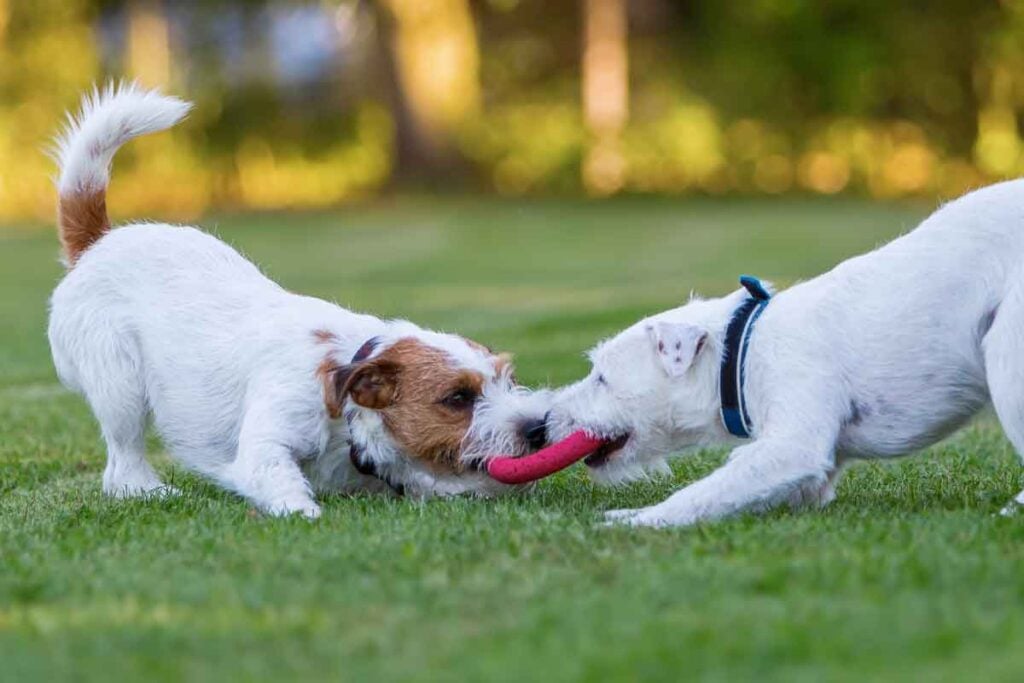Ever wondered how a simple game of fetch could be rewiring your dog’s brain? The science behind canine play is more fascinating than you might think. Play isn’t just about fun and games for our four-legged friends – it’s a powerful tool that shapes their cognitive development, emotional well-being, and social skills. Research shows that playful learning activates crucial neural pathways in your dog’s brain, enhancing problem-solving abilities and strengthening the human-animal bond. From puppy development to senior years, play serves multiple vital functions: • Develops essential motor skills and bite inhibition • Builds stress resilience and adaptive responses • Strengthens social bonds and communication • Provides crucial mental stimulation Whether you’re a new pet parent or a seasoned dog owner, understanding the science of play can help you create more meaningful interactions with your furry companion. Let’s explore how different types of play can boost your dog’s brain power and overall well-being.

Developmental Benefits of Play
Physical Development
Play serves as a crucial catalyst for motor skill development in dogs. Through various playful activities like chasing, wrestling, and fetching, dogs develop essential physical abilities. These activities strengthen their muscles, improve coordination, and enhance their overall agility. The role of play in physical development cannot be understated – it helps dogs master complex movements they’ll need throughout their lives.
When puppies engage in rough-and-tumble play, they learn vital skills like bite inhibition and body awareness. This natural form of exercise helps them develop balance, strength, and spatial awareness, which are fundamental to their growth and survival.
Cognitive Growth
Play isn’t just about physical activity – it’s a powerful tool for mental development. During play sessions, dogs learn to problem-solve, make decisions, and adapt to new situations. Whether they’re figuring out how to get a treat from a puzzle toy or learning the rules of a new game, their brains are constantly processing and growing.
Research shows that dogs who engage in regular play activities demonstrate improved memory and learning capabilities. The mental stimulation provided through play helps create new neural connections, keeping their minds sharp and engaged.
Social Skills Enhancement
Perhaps one of the most significant benefits of play is its impact on social development. Through play, dogs learn crucial social cues, appropriate behavior, and communication skills. When playing with other dogs or humans, they develop understanding of boundaries, learn to read body language, and practice important social interactions.
Play sessions provide safe opportunities for dogs to practice their social skills and build confidence in various situations. This social learning through play is essential for developing well-adjusted, friendly dogs who can interact appropriately with both humans and other animals.
Types of Play and Their Impact
Solo Play Activities
Dogs engage in various forms of solo play that significantly contribute to their cognitive development. When your furry friend plays alone with toys or engages in self-directed activities, they’re actually building crucial problem-solving skills. This form of playful activity helps them develop independence and self-entertainment abilities.
During solo play, dogs often practice natural behaviors like chewing, tossing toys, and investigating objects. These activities stimulate their brain by requiring them to figure out how things work, helping develop their cognitive abilities and confidence.
Interactive Play
Interactive play takes different forms, from engaging with other dogs to playing with human companions. This type of play activity is particularly valuable for social development and building trust. When dogs engage in play fight sessions with other canines, they learn vital social skills including bite inhibition and body language interpretation.
Human-dog interactive play strengthens the bond between pet and owner while providing mental stimulation. Whether it’s a game of fetch, tug-of-war, or hide-and-seek, these activities help dogs develop better communication skills and emotional regulation.
The social aspect of interactive play also helps dogs learn appropriate behaviors and boundaries. Through regular play sessions with others, they develop better impulse control and understand social cues more effectively.

Play as a Training Tool
Building Training Success Through Play
Play-based training transforms the learning experience for dogs by tapping into their natural instincts and motivations. When incorporated thoughtfully into training sessions, play becomes a powerful positive reinforcement tool that makes learning both enjoyable and effective.
A good dog trainer understands that play isn’t just about entertainment – it’s a sophisticated way to build focus, strengthen the human-animal bond, and create lasting behavioral changes. By using play as a reward, dogs become more engaged and enthusiastic about training sessions.
The key is to identify what type of play motivates your individual dog. Some dogs are motivated by fetch games, while others prefer tug-of-war or chase activities. Using these preferred play styles as rewards makes such training sessions more successful.
Play-Based Training Techniques
Start by incorporating short play breaks between training exercises. This helps maintain your dog’s interest and creates positive associations with learning new commands. Keep play sessions brief – 30-60 seconds is often enough to reinvigorate your dog’s focus.
Use toys strategically during training:
– Hold a favorite toy to maintain attention
– Reward successful behaviors with quick play sessions
– Integrate commands into play activities
– Use toys to guide movement and position
Remember to keep the energy upbeat but controlled. The goal is to use play as a structured reward that enhances learning, not creates overexcitement. End play sessions before your dog loses interest to maintain its value as a motivator.
Consistency is crucial when using play in training. Establish clear start and end signals for play breaks, and always follow through with promised play rewards. This helps your dog understand when it’s time to work and when it’s time to play.

